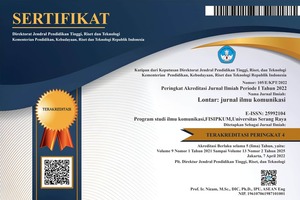Representation of Social Criticism through Morgans Journalist Characters in One Piece Anime: Examining the Meanings Behind and Propaganda
DOI:
https://doi.org/10.30656/lontar.v12.i2.9302Keywords:
One Piece, Morgans, Journalism, Social Criticism, PropagandaAbstract
This research analyzes the representation of social criticism through the journalist character Morgans in Eiichiro Oda’s manga series One Piece. The focus of this study is on the dilemmas faced by Morgans as a journalist in balancing journalistic integrity against political and power pressures. The method used is qualitative analysis with a semiotic approach to examine the meanings behind Morgans' actions and decisions in several critical chapters. The findings reveal that Morgans serves not only as a conveyer of information but also as a tool of propaganda, reflecting the complex reality of the media world. This study highlights how Oda uses Morgans to critique the role of media in shaping public opinion and manipulating facts. Morgans represents the ethical challenges in journalism, where the truth is often compromised for specific interests.
References
Audria, A., & M. Syam, H. (2019). Analisis Semiotika Representasi Budaya Jepang Dalam Film Anime Barakamon. Jurnal Ilmiah Mahasiswa FISIP Unsyiah, 4(3), 1–12. http://www.jim.unsyiah.ac.id/FISIP/article/view/11762/4805
Awaludin, A., & Rista. (2022). Penerapan Prinsip-Prinsip Jurnalisme pada Media Online Kotasubang.com. OMNICOM: Jurnal Ilmu Komunikasi, 8(1), 1–9.
Azwar, A., Uljanatunnisa, U., Maryam, S., & Supratman, S. (2020). Literasi Media Untuk Kemandirian Informasi Pondok Pesantren Mathla’ul Anwar Cijulang. Jurnal Studi Jurnalistik, 2(1), 81–92. https://doi.org/10.15408/jsj.v1i2.14584
Caron, J., & Markusen, J. R. (2016). 済無No Title No Title No Title. XV(2), 1–23.
Dewan Pers. (2016). Indonesia Menyongsong Jakarta World Forum for Media Development 2016. Jurnal Dewan Pers, 12, 100.
Fadli, A. (2018). Etika Dan Tanggung Jawab Jurnalis (Studi Pemberitaan Hoax Melalui Media Online Di Kota Makassar). Jurnal Jurnalisa, 4(2), 181–195. https://doi.org/10.24252/jurnalisa.v4i2.6893
Fianto, L., Ghofur, M. A., & Qorib, F. (2023). Implementasi Sembilan Elemen Jurnalisme Bill Kovach Dan Tom Rosenstiel Pada Berita Media Online. Jurnal Bincang Komunikasi, 1(2), 1. https://doi.org/10.24853/jbk.1.2.2023.1-9
Hafiizh, M. (2016). Peran Sosial Terhadap Persepsi Aktifis Mahasiswa Fisip Undip Sebagai Pemilih Pemula dalam Pilpres 2014. Journal of Politic and Government Studies, 4(3), 350–359. https://ejournal3.undip.ac.id/index.php/jpgs/article/view/8901
Hartoyo. (2011). The Structural Pressure , Political Opportunity , And Successful of Peasant Movement In Lampung. Agrisep, 10 No. 1, 80–93.
Hasan Kamaruddin. (2011). Propaganda Dan Opini Public. 1-4. Aceh : Universitas Malikussaleh.
Hastrida, A. (2021). Proses Pengelolaan Media Sosial Pemerintah : Manfaat Dan Risiko. Jurnal Penelitian Komunikasi Dan Opini Publik, 25(2), 149–165. https://doi.org/https://dx.doi.org/10.33299/jpkop.25.2.3920
Ismail, S. (2008). Analisis Wacana Krisis Alternatif Meganalisis Wacana. Jurnal Bahasa Unimed, 2. https://media.neliti.com/media/publications/74626-ID-analisis-wacana-kritis-alternatif-mengan.pdf
Juariyah. (2019). Opini Publik Dan Propoganda. 1–66. http://repository.unmuhjember.ac.id/13722/1/BUKU OPINI PUBLIK %26 PROPAGANDA pdf.pdf
Kharismawati, M., & Wahidati, L. (2023). Nakama: Reception on the Audience of One Piece Anime by Eiichiro Oda. ProTVF, 7(2), 218. https://doi.org/10.24198/ptvf.v7i2.41676
Khatimah, H. (2018). Posisi Dan Peran Media Dalam Kehidupan Masyarakat. Tasamuh, 16(1), 119–138. https://doi.org/10.20414/tasamuh.v16i1.548
Mata Hine, E. J. (2024). Psycho-Pass: Potret Masyarakat Kontrol dalam Kendali Sistem Algoritmik. Retorik: Jurnal Ilmu Humaniora, 12(1), 49–88. https://doi.org/10.24071/ret.v12i1.5773
Puji Rianto, SIP., M. (2021). Modul Meetode Penelitian Kualitatif. In Nuevos sistemas de comunicación e información.
Rivki, M., Bachtiar, A. M., Informatika, T., Teknik, F., & Indonesia, U. K. (n.d.). No 主観的å¥åº·æ„Ÿã‚’ä¸å¿ƒã¨ã—ãŸåœ¨å®…高齢者ã«ãŠã‘ã‚‹ å¥åº·é–¢é€£æŒ‡æ¨™ã«é–¢ã™ã‚‹å…±åˆ†æ•£æ§‹é€ 分æžTitle. 112.
Sampoerna, G. D. (2023). Representasi Kepahlawanan Pada Anime Boku no Hero Academia: Analisis Semiotika Roland Barthes Gasha Dhimar Sampoerna, Dr. Ardian Indro Yuwono, S.IP., M.A.
Siregar, A. G. (2021). “Studi Netnografi Terpaan Tayangan Anime One Piece Pada Perubahan Gaya Hidup Anggota Komunitas One Piece ID Medan.†Studi Netrografi Terpaan Tayangan Anime One Piece Pada Perubahan Gaya Hidup Anggota Komunitas One Piece ID Medan, 1–64.
Suliyansyah. (2023). Menepis hoax media sosial di tahun politik: pendekatan systematic literature review. Jurnal Adhyasta Pemilu, 6(1), 1–14.
Syafiq, A. N. (2022). Semiotic Analysis of Representation of Violence in Anime Attack On Titan (Semiotic Analysis Model of Charles Sanders Pierce). Unissula Institutional Repository, 1–98. http://repository.unissula.ac.id/id/eprint/27281
Thohir, M. (2020). Realitas Kehidupan dalam Perspektif Antropologis. Nusa: Jurnal Ilmu Bahasa Dan Sastra, 15(1), 76–83. https://doi.org/10.14710/nusa.15.1.76-83
Youna Bachtiar, A., Hikmah Perkasa, D., Rizki Sadikun, M., Arjuna Utara No, J., Tomang, T., Jeruk, K., & Barat, J. (2016). Peran Media Dalam Propaganda. Peran Media Dalam Propaganda Jurnal Komunikologi, 13, 78.
Downloads
Published
Issue
Section
License

This work is licensed under a Creative Commons Attribution-ShareAlike 4.0 International License.
By submitting an article to the journal, the author(s) agree to transfer the published article's copyright to the journal, which will act as the publisher. This means the journal will have the right to publish the article in various forms, including reprints. The journal will maintain the publishing rights to the published articles.
In line with the license, authors and third parties (readers, researchers, and others) are allowed to share and adapt the material. In addition, the material must be given appropriate credit, provided with a link to the license, and indicated if changes were made. If authors remix, transform, or build upon the material, authors must distribute their contributions under the same license as the original.





